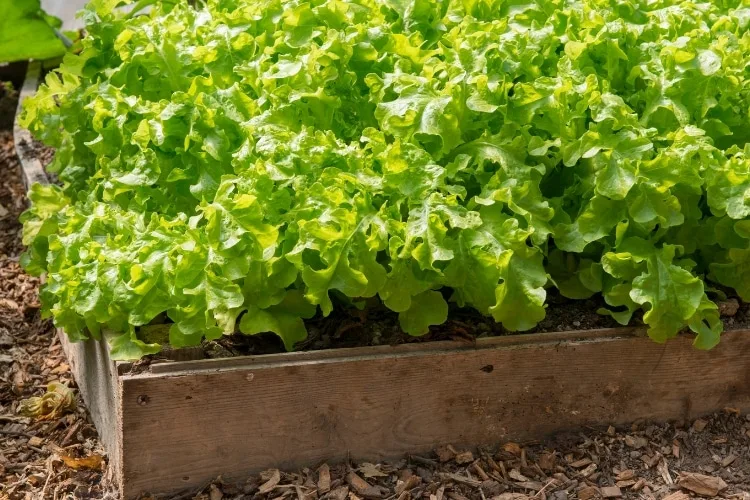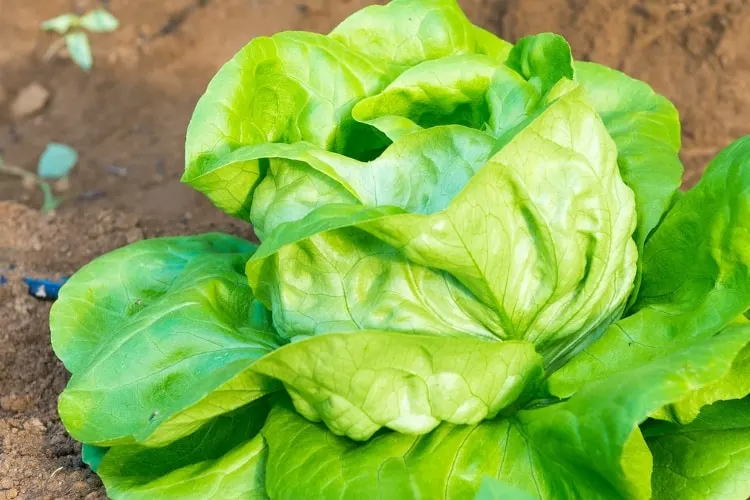
It probably doesn’t surprise you that the most popular salad vegetable grown in home vegetable gardens is lettuce. Lettuce is one of the fastest producing vegetables you can grow and the foundation of most salads. Unfortunately, growing lettuce can be a little tricky, especially in warmer climates.
However, as long as you understand a little bit about what lettuce requires and the differences in lettuce varieties, you can grow lettuce in any climate.
I like to keep track of how much of each crop to plant to feed my family for a year. It changes year to year but it gives me a good starting place. You can get the worksheets I use emailed to you by filling out the form below.
Tips for Growing Lettuce
Lettuce is a cool weather crop but it’s not as cold hardy as other greens, such as kale, chard, or even spinach. Lettuce grows best when the temperatures are between 60°F-70°F. The edges of lettuce tends to scorch when lettuce gets frost on it and lettuce will often wilt when it freezes.
We rarely have freezes here but when we do, I try to cover my lettuce. If you live in a colder climate, you can grow lettuce well into the winter by using row covers. Of course, there are many varieties of lettuce and some are more cold hardy than others.
Fortunately, lettuce is a fast growing crop and many varieties are fully mature in 30 days. However, lettuce can be harvested earlier than that in it’s immature stage.
Lettuce does best when it’s seeds are directly sown in the garden instead of transplanting. However, they can be started early indoors. Start lettuce seeds 3-4 weeks before your average last frost date. This is a great option for those of you that have a very short spring season.
Lettuce seeds are small and are a great candidate for making your own seed tape if you want your plants to be evenly spaced. However, I usually just scatter seeds and let them densely. A friend recently told me that her husband does the same thing, but through the growing season he will move a small lettuce plants throughout their garden so they can grow to maturity without competition. I think this is a great idea.
Lettuce roots are very shallow and will need to be watered often. This is sometimes hard to remember when it’s cool, but lettuce does best when it’s watered several times a week, if not daily.
Because lettuce matures so quickly, it’s a great for succession planting. Sow new seeds every couple of weeks to have lettuce all season long.
When it gets hot, lettuce will bolt (flower) and turn bitter. Don’t fight it, just accept it and move on to more warm weather greens that don’t get bitter, like kale and chard.
Fortunately, lettuce can be grown as microgreens indoors. This is a great option if you have long, hot summers like we do.

Lettuce Varieties for Backyard Gardens
There are five main types of lettuce with many varieties within those five types. You’ll want to choose the varieties you grow based on flavor, climate, and how you want to harvest the lettuce. Ask local gardeners what their lettuce varieties are…and why. Why, is a super important question.
While there are some differences in days to maturity, and cold and heat tolerance, all lettuces need the same growing conditions so don’t be afraid to mix and match lettuce varieties in your garden. You can find many different varieties of lettuce seeds at MiGardener Seed Company. All the seeds at MiGardener are non-GMO and most are just $2 a pack. You can get a 10% discount on your total order by using one of the links on my site.
Head Lettuce
Head lettuce, also called heading lettuce, rolls it’s leaves into a ball, like a cabbage. Head lettuce tends to be more heat tolerant than other lettuce varieties. The most commonly grown head lettuce is iceberg lettuce that has crisp, watery leaves.
You’ll want this variety to fully mature before harvesting. Of course, you can clip the outer leaves here and there but not until the head really begins to form.
Common head lettuce varieties are iceberg lettuce, crisphead lettuce, and red iceberg which is a red lettuce variety.
Leaf Lettuce
Leaf lettuce, or loose leaf lettuce, are fast growing lettuce varieties. Leaf lettuces grow an open head so you can harvest leaves a few at a time or the whole head. When you harvest the whole head, cut it about an inch above the soil. Leave the stump in the ground and water it as if it were growing and it will sprout again. It takes time, up to two weeks, for it to re-sprout but it’s a great cut and come again crop.
Common loose leaf green varieties are black seeded Simpson, oakleaf, Grand Rapids, and tango. Common loose leaf red lettuce varieties are ruby red leaf, lolla rossa, prizehead leaf, and red sails leaf lettuce.
Romaine Lettuce
Romaine lettuce, also known as cos lettuce, grows in an upright loose leaf head. The leaves have a deeper flavor than other leaf lettuces and romaine has a crunchy midribs.
Since romaine lettuce grows upright it’s more frost resistant than other loose leaf lettuces. When given plenty of water, romaine is one of the more heat tolerant lettuce varieties.
Common romaine lettuce varieties are Paris island romaine, freckles romaine (which is green with red freckles), red romaine, and cimmaron.
Butter Lettuce
Butter, or butterhead, lettuce form loose heads of melt in your mouth leaves, hence the name “butter”. Butterhead lettuces can be planted closer together than other varieties because the heads are smaller.
Common butter lettuce varieties are bibb butterhead, little gem butterhead, and buttercrunch.
Stem Lettuce
Stem lettuce, sometimes referred to as asparagus or Chinese lettuce, forms an enlarged seed stalk that is used in creamed, stewed, and Chinese dishes. Stem lettuces are usually bitter but the bitterness is muted when cooked.
Celtuce is a common stem lettuce variety that has a celery-like flavor.

Protecting Lettuce Against Pests and Disease
Lettuce is pretty easy to grow and is a great crop for beginning gardeners. Fortunately there are very few pests and diseases that bother lettuce.
The biggest pest problem I’ve had with lettuce is aphids. Aphid are little white insects that suck the moisture out of the leaves. There’s not much you can do to get rid of aphids except pick them off and encourage useful insects such as ladybugs who will feed on the aphids.
I notice that I have more trouble with aphids on greens when they mature and it starts getting warm. So, I try to harvest lettuce and other greens before they are fully mature and I pull the plants once I start to see an aphid infestation which is usually when the plants are spent but I’ve just left them in the ground.
Slugs, caterpillars, and snails can also be a problem for lettuce. I can usually spray lettuce with bt (bactillus thuringiensus) once and that will control the caterpillars all season. I don’t mind sharing with caterpillars once the plants are established so I usually just spray when I first notice that the lettuce is struggling from caterpillar damage.
We don’t have problems with slugs and snails but if you do you might want to read this from Oregon State about the effectiveness and safety of baits.

Harvesting and Storing Lettuce
Deciding when to pick lettuce is easy…pick it when it’s the size you want. Most lettuce varieties can be harvested between 30 and 70 days. If you want baby lettuce leaves you can harvest sooner.
If you scatter the seeds instead of spacing them, pull the small plants here and there to thin them. You can eat the leaves you thin.
Once the bed it thinned and everything is spaced well, you can harvest the outer leaves of the plants while the plant matures.
To harvest a head lettuce cut the head off the plant at the base. Sometimes the outer leaves of mature head lettuce are not super appetizing – they might get brown from laying on the ground or get partially eaten by slugs, snails, or caterpillars, these are great to putting in your worm composting bin or using as chop and drop mulch in the garden. I like to leave the roots in the ground to decompose and feed the soil.
To harvest leaf and romaine lettuce cut the plant off about an inch above the soil line. If you leave the roots in the ground, leaf lettuce will regrow.
Lettuce does not store well, so we try to harvest just enough for a day or two at a time. If we need to harvest more we will wash it, spin it in the salad spinner, and then roll it in a clean, slightly damp dish cloth and put in a glass storage container or ziplock bag, and store in the refrigerator. The towel helps the lettuce moist but not soggy.

Do you grow lettuce? What are your favorite lettuce varieties to grow and why? If you can, share where your live or what your climate is like for reference for us.

Jennifer
Wednesday 11th of March 2020
Thanks for the great article! I used a link and ordered from MIgardener. Going to see how lettuce does here in South Carolina. May try some in raised beds as well as pots on the patio.
Angi Schneider
Wednesday 11th of March 2020
That's a good idea to try lettuce in several different areas to see how it does. Thanks for using one of my links and supporting this site, it is much appreciated!
Helena
Monday 6th of May 2019
We love to grow lettuce because we eat a ton of salad and when food contamination recalls happen, it seems like salad greens are often on the list lately. And also we love butter lettuce, which is way cheaper to grow than to buy, at least here, but we've played with other varieties as well. We live in FL so once it gets hot we can't keep it from bolting, so it's a late fall through spring crop for us. One year at our old house, we did have good luck growing several heads in an enormous pot on our porch, but that porch faced north and I guess must have been slightly more lettuce-friendly, because in our house now the porch faces west and our success was not repeatable here.
If our lettuce (or other garden veggies) have bug-damaged bits, we give those to our hens. They'll eat the veg and the bugs too. :)
Angi Schneider
Thursday 9th of May 2019
Chickens are so great at helping us with your bugging vegetables. That's a good tip for growing lettuce in a hot climate. Our back porch faces north-ish, I might give it a try.
Helena
Monday 6th of May 2019
To clarify, we give the hens the damaged portions, not the whole thing! :)